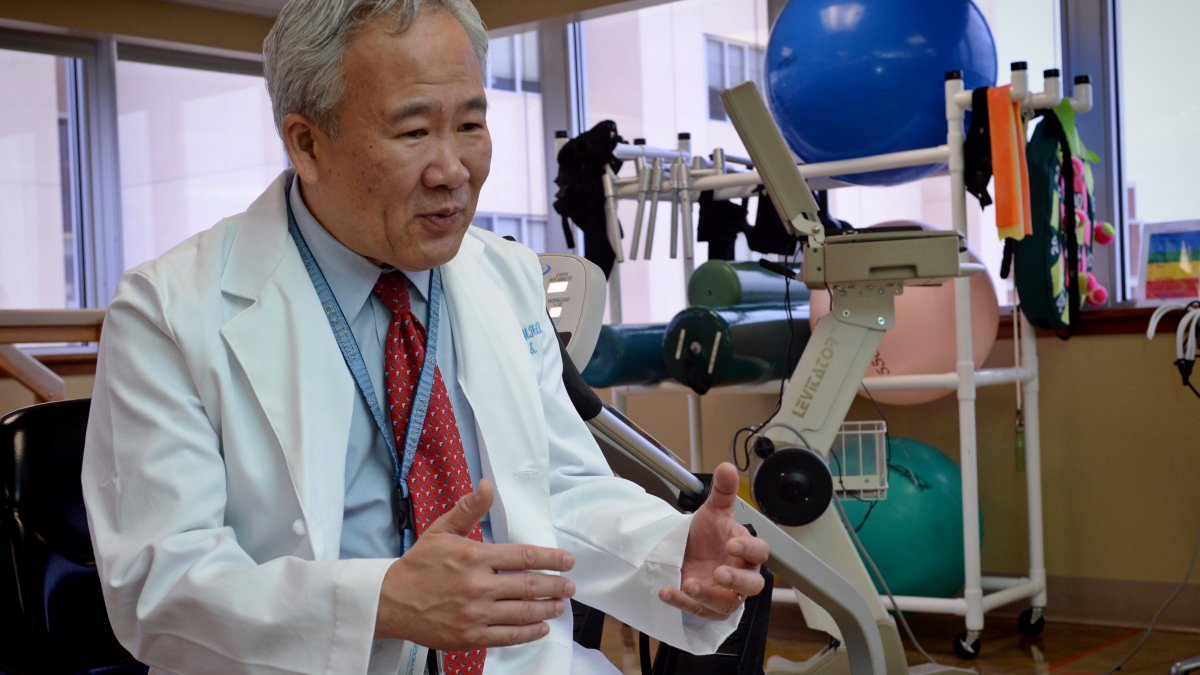Lee advocates treating the whole patient, not just the injury
Lee’s is a holistic approach, using experts from many disciplines to treat the patient and not just the injury.

When your father is a surgeon and your mother is an internist, odds are that you will be a medical professional, too. The only real question is what your specialty will be.
Michael Lee chose physiatry, also known as physical medicine and rehabilitation – and a very new field 30 years ago. He knew that was what he wanted to do in high school, when he had a summer job transporting patients at Oak Forest Hospital in Illinois.
“I met this patient who was a double amputee and blind, and he was trying to learn how to walk,” Lee recalled. The patient’s efforts were so inspiring, he said, “that’s when I knew I wanted to make a difference in the lives of people like him.”
When Lee came to Chapel Hill in 1994, he was the only physiatrist on staff. Within his first three months on the job, an administrator approached Lee with a serious problem in four of the programs. The patients were lingering too long – bedridden, weak and susceptible to infections – in the trauma, total joint replacement, rehabilitation and stroke units.
Lee saw only one tangible problem: The hospital was not providing rehabilitation services to patients quickly enough. By making sure patients got the help they needed – physical therapy, pain relief medication, devices and aids, even psychological counseling – early in the treatment process, he turned the troubled units around.
“That was a big impact we made early,” he said.
Lee founded the UNC Department of Physical Medicine and Rehabilitation 20 years ago as chair of the department. Recently he was named the Sidna Chockley Rizzo Distinguished Professor of Physical Medicine and Rehabilitation.
Under his leadership, the department has doubled its inpatient capacity and added multiple outpatient facilities where thousands of patients a year are treated. The faculty now includes 15 physiatrists – more than there were in the entire state 20 years ago.
Lee’s is a holistic approach, using experts from many disciplines to treat the patient and not just the injury. The interdisciplinary approach and the complexity of the patient’s condition are what separate physiatry from its components.
One example is the Brain and Body Health Program that Lee co-directs with Kevin Guskiewicz, who also is research director for the Center for the Study of Retired Athletes and Kenan Distinguished Professor of Exercise and Sport Science.
The Brain and Body Health Program screens former NFL players who pushed their bodies’ limitations for years and offers them services such as neuropsychological evaluation, magnetic resonance imaging, a body composition and dietary consultation by an exercise physiologist, and life skills coaching and transition counseling.
But that is only a small segment of the physical medicine and rehabilitation department’s work. Every day, Lee’s staff works with a wide variety of patients, from children born with spina bifida to senior citizens crippled by arthritis. Staff members also help cancer and surgery patients weakened by their treatments, people with spinal cord injuries, stroke victims and amputees.
The in-patient facility on the seventh floor of UNC Memorial Hospital includes 30 hospital beds and a gym equipped with mats, exercise balls and parallel bars, as well as cots and stairs for patients to practice their skills.
The staff wants to be sure that patients are ready to handle everyday living when they are discharged from the hospital. Before going home, each patient must spend a night or two in the department’s transitional apartment to practice showering, cooking and getting in and out of chairs.
Even turning over in bed can be a challenge. “We take it for granted,” Lee said, “but it takes some practice for patients who have certain difficulties.”
The UNC Center for Rehabilitation Care, the outpatient facility housed in the former Borders bookstore on Fordham Boulevard, offers similar services, plus a driving simulator so patients can test their skills before hitting the road.
Much has changed in the field of rehabilitation over the past 20 years. Prosthetic devices and electric stimulation have made walking easier for amputees. Wheelchairs are lighter and faster. Implanted devices can deliver medications to treat spasticity when patients need them most.
In the future, Lee hopes these technologically advanced devices will become more common and less expensive.
“Even a simple device, like a functional electrical stimulation device, costs $15,000,” he said. “Most patients cannot afford it, and insurance won’t pay for it.”
The caregivers have benefited from advances in technology as well.
“One of our pediatric physiatrists, Dr. Josh Alexander, has pioneered a program called Telability,” using videoconferencing to evaluate patients from far away and educating family and therapists about how to care for them, Lee explained.
The basic methods for working with patients, however, have not changed, he said. “It does take a lot of the human touch, a lot of manpower to teach patients and family members how to cope with the conditions the patients have.”
As it was 20 years ago, Lee’s goal is to make sure a patient’s medical team keeps rehabilitation in mind from the beginning of treatment, not when the patient is released.
To promote this mindset, Lee has incorporated both residency training in physiatry and physical medicine rotations for Carolina and visiting medical students, no matter what their specialty.
Most important, he said, his mission remains the same: “to improve the function and quality of life of the people we serve.”




